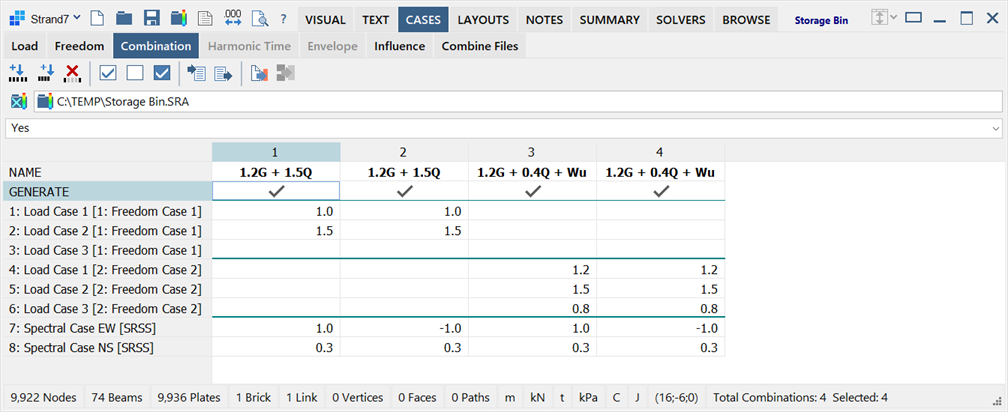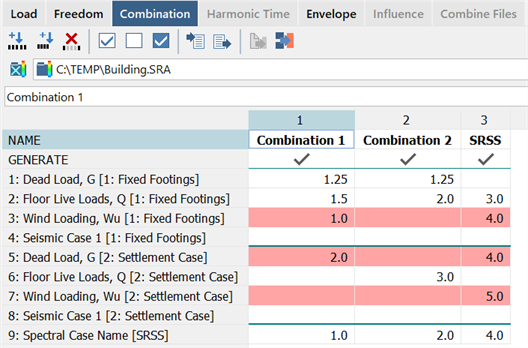CASES: Combination Cases

Description
Defines linear load case combinations comprising of primary result cases and/or spectral response SRSS and CQC result cases added together according to specified load factors to produce additional secondary load cases (the combinations). Once generated, combination cases are added to the result case dropdown list in the model window (VISUAL: Cases) and to the Cases list of The LISTINGS Tab.
Combinations offer the possibility to examine the combined effects of primary load cases acting together without having to explicitly define new load cases with factored node and element attributes. Instead, the combinations are performed by combining the results of the primary cases; attributes are implicitly combined.
All of the result quantities (displacements, stresses, strains, reactions, etc.) available in the included primary cases are combined into the secondary cases.
Depending on the result options specified for the model (Result Settings: Combinations Tab), combinations are calculated whenever a linear static result file is opened for a model that has combinations defined. The combinations are generated by the post-processor. The advantage of this is that the model does not need to be re-solved when the combination factors are changed or when combinations are added or deleted. The main disadvantage of this is the additional processing time required to generate the combinations. However, once generated, the combinations can be stored for future reuse, avoiding the need to recalculate them every time the result file is opened. Depending on the Result Settings: Combinations Tab, whenever the result file is closed, a dialog appears asking whether the combination should be saved to file.
Additionally, the linear static solver offers the option to calculate the combinations and store the combination file as part of the linear static analysis process (see SOLVERS Load: Linear Static and Load Influence).
Note that if the model is re-solved after generating and saving a combinations file, that file will no longer be compatible with the model and will not be offered as an option for post-processing the next time the results are opened.
Linear static result files generated by CASES: Combine Files may also be used for generating combinations.
A function also exists to generate new primary load cases with load attributes combined according to the combination definition.
Toolbar Functions
Insert combination
Inserts a column before the highlighted cell for a new combination definition.
Add combination
Adds a column to the end of the list for a new combination definition.
Delete selected combinations
Deletes the highlighted columns, thereby deleting those combinations.
Import data
Uses the Open File dialog to import a previously saved .LCF (load case factors) file containing load case combination factors.
Export data
Uses the Save File dialog to export the load case factors and combinations into an .LCF (load case factors file) so that it can be imported into another model.
Create primary load cases from combinations
Generates one new primary load/freedom case pair for each selected combination. The new primary load cases will contain load attributes scaled and summed according to the combination definition. The new freedom cases will contain node restraint attributes scaled and summed according to the combination definition
When multiple non-structural masses are combined into a new primary load case, the combined mass term will be equal to the sum of the products of the individual masses and the combination load factors, while the combined dynamic factor will be equal to the ratio between the combined dynamic mass and the combined mass term.
For example, two load cases with 1.2 kg of non-structural mass and dynamic factors of 1.0 and 1.5 respectively, combined with factors of 0.8 and 0.7 respectively, will produce a combined dynamic mass of 1.2´1.0´0.8 + 1.2´1.5´0.7 = 2.22 kg. The combined mass term will be 1.2´0.8 + 1.2´0.7 = 1.8 kg and therefore the combined dynamic factor will be 2.22/1.8 = 1.233. The attribute is then stored as a 1.8 kg mass together with a 1.233 dynamic factor.
This function is not available when a results file is open.
Generate combinations
Generates the combinations, adding one new secondary result case for each active combination. Only active combinations, those marked with the GENERATE checkmark, are generated. Once generated, combination cases are added to the result case dropdown list in the model window (VISUAL: Cases) and to the Cases list of The LISTINGS Tab.
This function is only available when a linear static results file (.LSA) is open.
Select Spectral Response Results File
Displays the Open File dialog to select and include a single spectral response solution file (.SRA) into the combinations. All SRSS and CQC result cases contained in the spectral response file will be available in the combinations grid for inclusion in one or more combinations.
Dismiss Spectral Response Results File
Dismisses the spectral response solution file from all combinations. Does not delete the spectral response file.
Right-click Functions
Right-clicking the spreadsheet area opens a popup menu and provides additional functions. See Strand7 Interface: Right-click Functions.
Incompatible Results
When opening a result file that does not contain all of the result cases referenced by the combinations, a warning message is given.

The invalid combination rows (i.e., the missing result cases) are highlighted while the result file is open.

See Also